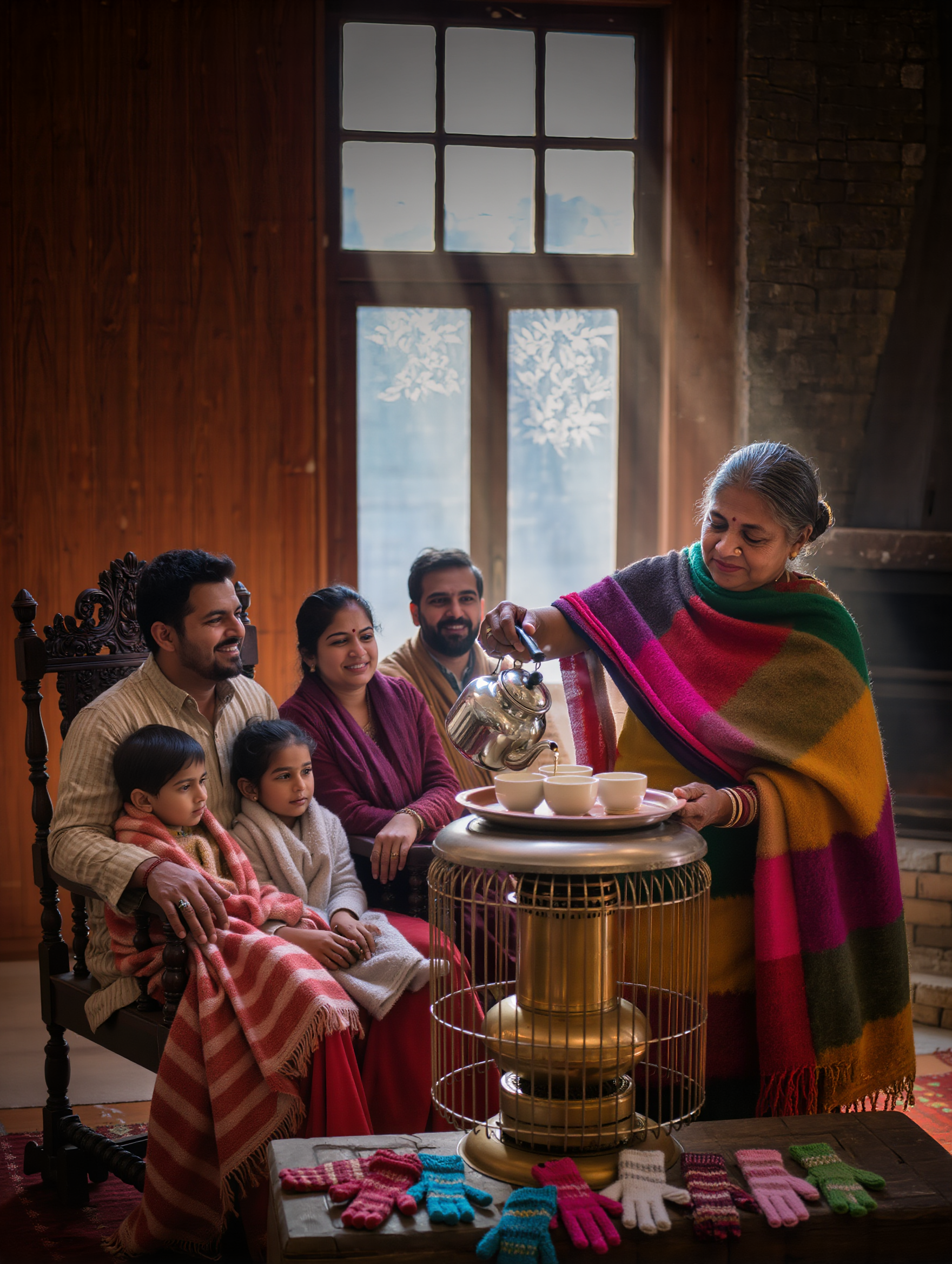Winter Care in Ayurveda – Real Life Ayurveda Guide for Elders and Children
Winter care in Ayurveda
You can always tell winter is here in India without checking the calendar. It’s not subtle at all. The mornings suddenly feel slower, people start sunning their blankets on rooftops, and someone in the family announces, “Ab toh methi parathe ka season aa gaya.” That’s it. Winter has officially begun.
There’s also that distinct “winter smell” — not romantic like in movies, but the smell of fog mixing with chai, mustard oil, and something earthy. If you grew up in North India, your body probably remembers this change better than your mind.
And every winter, without fail, you notice the same two groups struggling the most: children and elders.
Not because they’re weak — but because winter genuinely affects them differently. And this is where Ayurveda suddenly stops sounding ancient and starts sounding surprisingly practical. Winter care in Ayurveda steps in.
I didn’t need research papers to see this, but I looked anyway. According to Ayurveda’s classical texts, winter (Hemant and Shishir) increases Vata, which is associated with dryness, cold, roughness, and unpredictable energy. That pretty much describes every elder I’ve ever seen in December. And kids? Their immunity is still developing, so anything that dries out the body hits them quickly.
But enough theory. Let’s talk about the real, everyday things we see and to be done as winter care in Ayurveda.
What Winter Does to Elders
If you live with aging parents or grandparents, just observe them in winter. They don’t verbalise discomfort all the time, but winter shows on them:
- Their knees complain even while sitting.
- Their fingers stay cold no matter how much they rub them.
- Sleep gets lighter and broken.
- Digestion slows down — this is documented in Ayurveda as decreased digestive mobility when Vata rises.
- They look for sunlight like plants.
There’s a reason for this:
The Ayurvedic texts describe that Vata accumulates in early winter and becomes aggravated in later winter, making joints dry and stiff. Research-backed modern explanation? Cold constricts blood vessels, reducing circulation, which increases joint stiffness - reason to follow winter care in ayurveda regime.
What Winter Does to Kids
Kids practically become a magnet for coughs and colds this season. If one child in the class sneezes, half the class follows.
Winter does three main things to them:
- Their nasal passages dry out → viruses stick easily.
- They drink less water → dehydration weakens immunity.
- School timings + cold mornings → body stress increases.
Ayurveda adds another angle:
Kids naturally have a “Kapha-dominant” phase of life. In winter, Kapha thickens. That basically explains every blocked nose in every Indian household.
And yet, children also bounce back faster than adults — which means winter care in ayurveda is more about prevention than cure.
The Real Winter Routine That Actually Works (From Ayurveda and Real Life)
This is not fancy.
This is the kind of winter care that existed before dietitians, influencers, and apps.
- Warm water is the backbone.
Not boiling hot. Just warm enough to feel comforting.
Ayurvedic research shows warm water supports Agni (digestive fire). Modern research shows warm fluids clear nasal congestion and improve circulation.
Take your pick.
- Oil massage — not spa-style, just functional.
Two minutes on knees, feet, back. That’s it.
Sesame oil is traditionally recommended in winter because it’s warming and Vata-pacifying.
There’s a reason your dadi always used mustard oil.
- Sunlight between 9:30 am — 11:30 am.
The perfect natural mood and immunity supplement.
Also: Vitamin D, joint relief, better sleep, better digestion… the list goes on.
- Warm, simple, home-cooked food.
Forget exotic wellness recipes.
Indian winter food is already Ayurvedically correct:
- bajra roti
- methi paratha
- sarson ka saag
- carrot halwa (real one, not bakery sugar bombs)
- ghee
- amla
- moong dal khichdi
- pepper soups
- sesame (til)
Every one of these is mentioned in Ayurvedic winter care recommendations.
- Zero cold food at night.
Ayurveda told us centuries ago that digestion dips at night.
Modern gastroenterology agrees.
- Ear and feet warmth for kids.
This one sounds funny, but ask any grandmother — she’ll give you a full lecture on how open ears + cold air = trouble.
Ayurveda calls the ears “a pathway of Vata.”
Makes sense.
This winter care in ayurveda regime is to be understood in a broad way to be followed.
Where Chyawanprash and The Shield Fit Naturally (Not as “products,” but as part of the season)
Let’s be practical.
If India had to pick one winter supplement that survived generations, it would be Chyawanprash.
When I dug into its origins (beyond the ads), here’s what I found:
- It’s based on the Rasayana concept — rejuvenation therapy.
- Amla is its core — one of the richest natural sources of Vitamin C.
- Over 40 herbs are blended to support immunity, lung strength, digestion, and energy.
- Classical Ayurvedic texts recommend it specifically during cold seasons because it balances Vata.
And elders KNOW this. The way they take Chyawanprash is almost ceremonial.
For kids, it works differently — gives them steady immunity and cuts down the “school se thand lag gayi hogi” frequency.
Now The Shield —
It’s like a modern winter bodyguard built on classic herbs:
- Tulsi → respiratory support
- Ashwagandha → stress & strength
- Mulethi → throat protection
- Haridra (turmeric) → anti-inflammatory properties
- Pippali → supports lung function
- Punarnava, Bala, etc → overall vitality
It’s not a “quick fix.”
It’s a daily protector, especially in winter.
Many families naturally combine both:
- Chyawanprash in the morning
- The Shield in the evening
One nourishes, the other strengthens.
Winter Foods Backed by Ayurveda
Ayurveda suggests more snigdha (unctuous), ushna (warm), guru (nourishing) foods in winter.
But nobody in real life says this.
People say:
“Ghee thoda aur daal lo."
“Til ka laddoo khao, badan garam rehta hai.”
“Methi khane se sardi nahi chipakti.”
All of these are true both scientifically and Ayurvedically.
What winter wants from us:
Warmth. Moisture. Grounding.
What winter hates:
Cold water. Raw salads at night. Skipping meals. Bare feet.
Last Thought
I’ve seen enough Indian winters to know one thing:
Cold weather is not the villain.
Neglect is.
Kids don’t need complicated routines.
Elders don’t need medicines for every ache.
Families don’t need imported supplements.
Winter care in Ayurveda is mostly simple, homey, predictable habits —
the kind every household once followed naturally.
Warm water.
Warm meals.
A bit of oil.
A bit of sunlight.
Chyawanprash in the morning.
The Shield in the evening.
And a mindset that says:
“Let me protect this body instead of pushing it.”
This winter, may your home feel like a warm blanket —
soft, steady, nourishing.
FAQs on Winter Care in Ayurveda
1. Why does the body feel different in winter according to Ayurveda?
As per winter care in Ayurveda, winter increases Vata—the dosha linked to cold, dryness, and stiffness.
That’s why skin gets dry, joints feel tight, and digestion becomes sensitive.
Keeping the body warm and well-nourished helps balance Vata naturally.
2. Why do elders need extra winter care?
With age, Vata is already dominant in the body.
Winter pushes it further — resulting in stiffness, poor sleep, low warmth, and weaker immunity.
Even simple things like warm water, oil massage, and sunlight make a huge difference for elders. This is where winter care in Ayurveda steps in for elders.
3. Why do children fall sick more often during winter?
Children are in the “Kapha phase” of life.
Winter increases Kapha, leading to congestion, cough, runny nose, and slow digestion.
Warm food, regular hydration, and simple Ayurvedic support help reduce repeated infections.
4. Is oil massage really helpful in winter?
Yes — very.
Warm oil massage (Abhyanga) calms Vata, improves circulation, reduces stiffness, and hydrates the skin.
Even a quick two-minute oiling of feet or knees daily can help.
5. How important is sunlight in Ayurvedic winter care?
Extremely important.
Winter sun improves mood, supports immunity, enhances sleep patterns, and reduces joint discomfort.
Ayurveda considers sunlight naturally strengthening (balya).
6. What is the simplest way to follow winter care in Ayurveda?
Think of it this way:
Warmth in food, warmth in routine, warmth in lifestyle.
Warm meals, warm oil, warm clothes, warm sun —
and staying emotionally warm with your family.
These basics alone keep the body balanced in winter.
Dr Laxmi Saxena
From J-AMADA Remedies
Still committed to Preserving Life, one season at a time.










 Know your Dosha
Know your Dosha